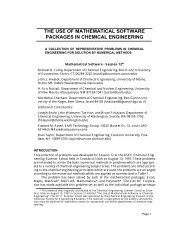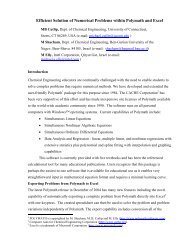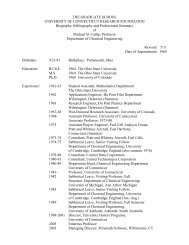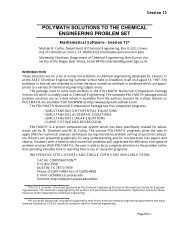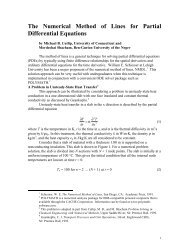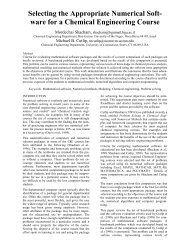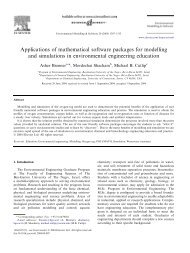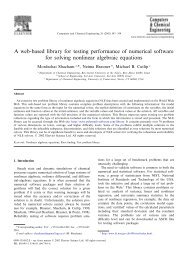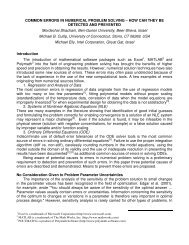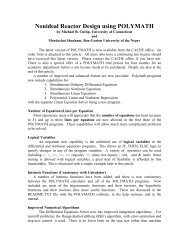Maple Solutions to the Chemical Engineering Problem Set
Maple Solutions to the Chemical Engineering Problem Set
Maple Solutions to the Chemical Engineering Problem Set
You also want an ePaper? Increase the reach of your titles
YUMPU automatically turns print PDFs into web optimized ePapers that Google loves.
obtaining numerical solutions <strong>to</strong> systems of equations. We use fsolve in several of <strong>the</strong> examples.<br />
However, in this authors opinion fsolve is not very effective at solving systems of nonlinear equations<br />
(i.e. more than one), largely because <strong>the</strong> procedure allows <strong>the</strong> user no control over <strong>the</strong> starting point,<br />
or over <strong>the</strong> iteration his<strong>to</strong>ry. To deal with this weakness in <strong>Maple</strong> I have implemented New<strong>to</strong>n's method<br />
for solving systems of equations in <strong>Maple</strong>. The procedure is moderately sophisticated and has<br />
numerous options that allow <strong>the</strong> user considerable control over how <strong>the</strong> calculations are <strong>to</strong> be done.<br />
The code has been part of <strong>the</strong> <strong>Maple</strong> Share Library (contributions by users) for some time. A more up<br />
<strong>to</strong> date version is included with <strong>the</strong>se examples.<br />
<strong>Maple</strong> out of <strong>the</strong> box is not capable of solving problems involving mixed systems of differential and<br />
algebraic equations (DAEs). However, in view of <strong>the</strong>ir importance in what we do with <strong>Maple</strong>, we have<br />
implemented a numerical method for solving DAE systems. Full details of <strong>the</strong> method are available in<br />
<strong>the</strong> worksheet BSIRKPAP.MWS that has been included with this collection of problem solutions. The<br />
code that implements <strong>the</strong> method is contained in <strong>the</strong> file BESIRK and is loaded in<strong>to</strong> <strong>the</strong> relevant<br />
worksheets using <strong>the</strong> read command. This method is also used in an alternative worksheet <strong>to</strong> one of <strong>the</strong><br />
o<strong>the</strong>r examples where <strong>Maple</strong>'s own dsolve/numeric is ano<strong>the</strong>r choice. Possible reasons for using<br />
BESIRK over dsolve/numeric include <strong>the</strong> fact that BESIRK is many times faster. It can also be useful<br />
in solving systems of PDEs obtained when systems of PDEs are approximated using <strong>the</strong> method of<br />
lines.<br />
The code packages used here as well as <strong>the</strong> example files are available by anonymous ftp from<br />
ftp.clarkson.edu in <strong>the</strong> \pub\maple direc<strong>to</strong>ry. Utilities are in <strong>the</strong> \utils subdirec<strong>to</strong>ry, New<strong>to</strong>n's method in<br />
\numerics, BESIRK in \besirk. O<strong>the</strong>r exmaples are available in <strong>the</strong> \chemeng subdirec<strong>to</strong>ry. The<br />
worksheets that follow are in <strong>the</strong> \polymath subdirec<strong>to</strong>ry.



